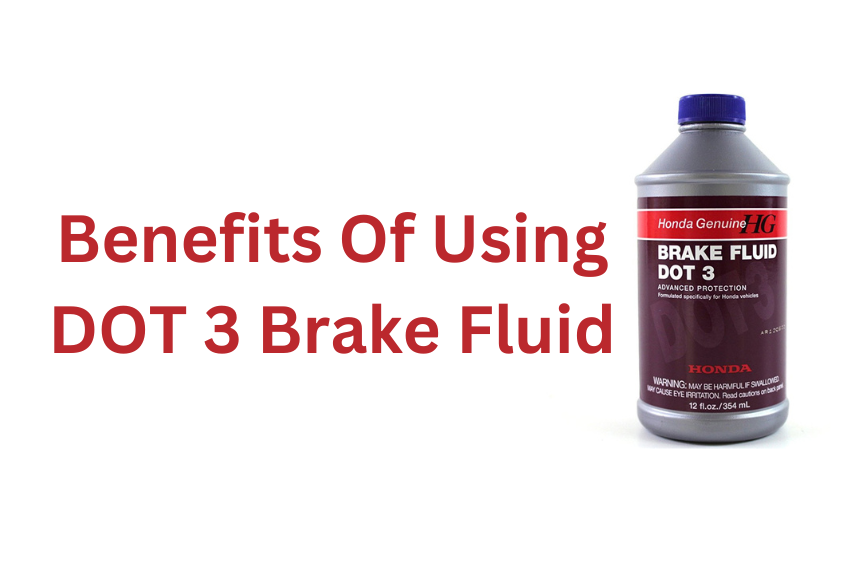DOT 3 brake fluid is a popular choice for many drivers.
However, In this comprehensive, you’ll learn about its key benefits and how it can improve your vehicle’s performance.
What Are The Key Benefits Of Using DOT 3 Brake Fluid?
DOT 3 brake fluid is a popular choice among drivers due to its accessibility, affordability, and reliability.
It’s a versatile option that’s compatible with most brake systems, making it a suitable choice for a wide range of vehicles.
Accessibility And Affordability:
One of the biggest advantages of DOT 3 brake fluid is its widespread availability.
You can easily find it at most auto parts stores and service stations.
This accessibility, combined with its competitive pricing, makes it a popular choice for budget-conscious drivers.
Compatibility:
DOT 3 is designed to work seamlessly with a variety of brake systems.
Whether you drive a sedan, SUV, or truck, DOT 3 is likely a compatible option.
This versatility ensures that it can be used in a wide range of vehicles.
Reliability:
DOT 3 has a proven track record of reliability and performance.
It’s designed to provide effective braking in different driving conditions, from city streets to highways.
While it may not offer the same level of performance as higher-grade brake fluids like DOT 4, it’s still a reliable choice for most drivers.
Maintenance:
While DOT 3 requires regular maintenance, it’s generally easier to maintain compared to some other brake fluids.
This includes checking the fluid level and replacing it as needed.
Following the recommended maintenance schedule will help ensure optimal performance and safety.
Is DOT 3 Brake Fluid Suitable For All Vehicles?
It’s not suitable for all vehicles.
Certain factors, such as the vehicle type, driving conditions, and manufacturer recommendations, influence its suitability.
High-performance cars that experience extreme braking conditions may benefit from a higher-grade brake fluid like DOT 4.
These fluids have a higher boiling point, which can help prevent brake fade under heavy use.
If you frequently drive in extreme temperatures or engage in off-roading or heavy-duty towing, a higher-grade brake fluid might be more appropriate.
These demanding conditions can put extra stress on the brake system, and fluid with superior heat resistance can help ensure optimal performance.
The most reliable way to determine the best brake fluid for your vehicle is to consult your vehicle’s owner’s manual.
The manufacturer will provide specific recommendations based on the design and engineering of your car.
Read Also: DOT 3 Brake Fluid: The Definitive Guide
Can I Use DOT 3 Brake Fluid In A Classic Car?
While DOT 3 is a versatile option, its suitability for classic cars can depend on several factors.
Age Of The Vehicle:
Older classic cars might have different brake system requirements.
Some older systems might be designed to work with specific types of brake fluid.
For example, some older models might have used a type of brake fluid that is no longer readily available.
Brake System Components:
The materials used in the brake system can influence the suitability of DOT 3.
Some older systems might have components that are not compatible with modern brake fluids.
For instance, certain rubber seals or hoses might react negatively to DOT 3.
Restoration Or Modification:
If your classic car has undergone recent restoration or modifications, the brake system might have been updated to accommodate modern brake fluids.
In these cases, DOT 3 would likely be a suitable choice.
Local Regulations:
In some regions, there might be regulations regarding the use of specific brake fluids in classic vehicles.
It’s important to check local laws and regulations to ensure compliance.
What Are The Potential Risks Of Using Outdated DOT 3 Brake Fluid?
Using outdated DOT 3 brake fluid can pose several risks to your vehicle’s safety and performance.
Over time, DOT 3 can absorb moisture from the air, which can lead to reduced boiling point, corrosion, and compromised braking performance.
Reduced Boiling Point:
One of the primary concerns with using outdated DOT 3 brake fluid is a reduced boiling point.
As the fluid absorbs moisture, its boiling point decreases.
The fluid can boil more easily, especially during heavy braking or in hot weather.
When the fluid boils, it creates vapor, which can reduce the pressure in the brake system and cause brake fade.
Corrosion:
Outdated DOT 3 brake fluid can also become acidic over time.
This acidity can lead to corrosion of the different components in the brake system, such as the calipers, rotors, and brake lines.
Corrosion can weaken these components, making them more susceptible to failure.
Compromised Performance:
Using outdated DOT 3 brake fluid can significantly compromise the braking performance of your vehicle.
This can lead to longer stopping distances and reduced control, increasing the risk of accidents.
